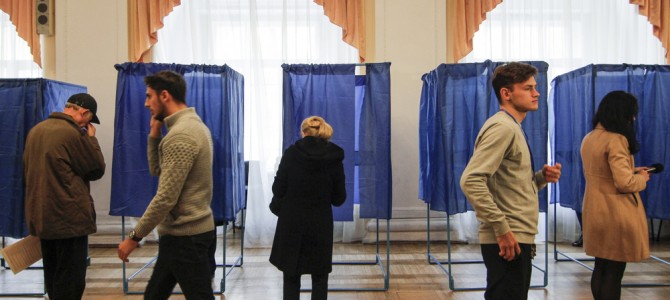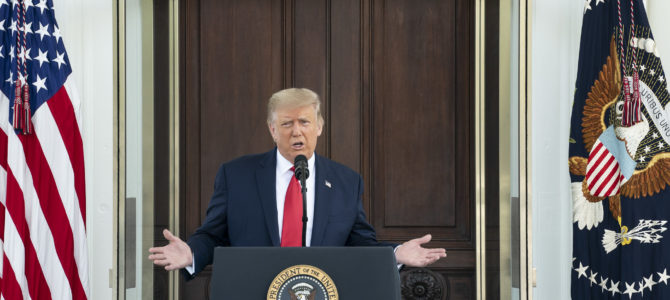
The Republican presidential primary field is shattered this year. Most of the benefit has been in favor of Donald Trump, who commands a fervent 30 to 40 percent of the vote in most states. The majority of Republican voters scattered their votes among several mainstream candidates. Supporters of each are now calling on the others to drop out and join with their man in victory. The consolidation is happening, but more slowly than the anti-Trump forces would like.
Marco Rubio, Ted Cruz, and John Kasich were locked in a three-way game of chicken, each demanding that the others turn away first. Rubio went first, but Kasich and Cruz still may divide the field enough for Trump to wiggle through with a plurality. The problem seems intractable for Republican regulars, but an alternative system of voting offers a solution for the future, if not for 2016.
Rubio’s victory in the Puerto Rico Republican primary was an unremarked-upon milestone in the 2016 race: it was the first time any candidate won more than 50 percent of the voters in a Republican primary contest. In smaller contests later, Cruz and Trump took majorities in caucuses in Wyoming and the Northern Mariana Islands, respectively, but every other primary and caucus has resulted in more people voting against the winner than for him.
This has allowed the frontrunner, Trump, to claim victory with vote percentages as low as 33 (Arkansas, Vermont). Cruz’s victories have included similarly low tallies of 34 percent (Oklahoma) and 36 percent (Alaska), and Rubio’s only victory outside Puerto Rico had him winning just 37 percent of Minnesota caucus-goers. For all his talk of inevitability, Trump has never won a majority in any state primary.
The Winningest Loser Ever
These contests have all involved states where the delegate allocation has been proportional, so the results can be said to roughly reflect the will of the voters. But as we saw in the winner-take-all primaries, we will now see some candidate take all of a state’s delegates after an election in which the vast majority of voters will have voted against him.
Elections conducted under these rules could result in Trump winning a majority of Republican delegates and the nomination, despite never winning a majority of voters in any election. Given how different he is from Cruz, Rubio, and Kasich, it seems likely that this will not be the result a majority of Republican voters prefer.
Mitt Romney called for a strategy many of the “Never Trump” partisans have favored: concentrating the vote on one non-Trump candidate in each state. Romney suggested voting for Rubio in his home state of Florida, Kasich in his home state of Ohio, and Cruz in states where he seems likely to be the most popular non-Trump candidate. This is a good strategy as far as it goes, but it requires millions of people to vote strategically in a way that is nearly impossible to coordinate. Some will go along with it, but in states besides Florida and Ohio, many will not agree on which candidate should gain the strategic votes.
Instead, Rank Your Preferences
The answer is instant-runoff voting (IRV). Under IRV (also called “ranked preference voting” and “alternative voting,”) voters rank all of the candidates on the ballot in order of preference. In Australia, voters are required to rank all the candidates. In Ireland, they are not, which would probably be the more popular approach here.
There’s not much to it: take a look at the ballot pictured below. The only skill required is knowing how to count. Given that half of what we read on the Internet these days is “Top 10 somethings” or “The 20 best whatevers of all time,” ranking things should be second-nature to us.

In a primary, that is often what we do already, mentally, as we consider our options. When it comes to the vote, however, we are only able to select the candidate at the top of that mental list. The rest of our rankings are never given effect. With IRV, the voter’s complete opinion on the race is taken into account, leading to a victory for the candidate that best represents the consensus of the electorate.
How it works is best illustrated with an example. Imagine an election like in a state like California, a winner-take-all state, where none of the four candidates have a home-state advantage. Imagine this result: Trump 38, Cruz 36, Kasich 23, and others 3. In an election under our current system, the calculations would stop there. Trump, with 38 percent, would take all of California’s 172 delegates.
Under an IRV system, we have more information about what the voters actually want. With no candidate receiving a majority, the next step is to eliminate the candidate with the fewest votes. The vote-counters then look at the ballots that listed that candidate first and distribute those votes according to those voters’ second choices.
Right away, this solves one of the problems we have seen in this election: because so many states have early voting, a significant number of voters have been casting ballots for candidates who were in the race when early voting began, but out of it by election day. Others may vote for a former candidate out of loyalty, confusion, or as a protest vote. In Michigan, 438 people voted for Lindsey Graham, for reasons known only to themselves. Currently, those votes are all wasted. Under instant-runoff voting, those voters’ second and third choices could be taken into account.
Getting to a True Consensus Outcome
Let’s imagine for the sake of simplicity that all of the early voters and bitter-enders divided their second choices evenly among the remaining four candidates. After allocation, that leaves us with: Trump 39, Cruz 37, and Kasich 24. Not much changes, but now it starts to get interesting. With each round of counting, if no candidate has a majority, the last remaining candidate is eliminated. With the group down to three, that means third-place Kasich is out.
With only two candidates remaining, a majority is now certain. Because it’s not a question asked on many surveys, we don’t know for sure who those Kasich voters would have as their second choice. Considering the many polls, like this one, suggest Cruz is the second choice of more voters than Trump, however, we can estimate that Kasich’s voters would give their second preferences to Trump 61 percent of the time, and Cruz 39 percent. After distributing those, the new tally would be Cruz 53.6, Trump 46.4. A majority of voters would have chosen, after all of their previous preferences had failed to reach a majority, Ted Cruz as the winner of their state’s delegates.
This is not a specifically Trump-proof plan. If more voters listed Trump as a second or third choice than Cruz, he would still win, but at least it would be clear that he was the consensus choice of the voters. Trump currently claims to be the only legitimate choice for the nomination because he has “won” the most states. Under IRV, a state winner would have more legitimacy to make such a claim.
This Shouldn’t Introduce Effects We Regret
Many of the problems of the 2016 primary calendar come from the Republican Party trying to avoid the problems of 2012’s primaries. Would this change be similar? Would instant-runoff voting create more problems than it solves in 2020?
On balance, it seems unlikely. The system has been in use in a few American municipalities (including some in California) and in countries around the world for decades, so there is an established pattern of successful use. Because IRV gives us a more complete picture of the voters’ opinions, it tends toward a consensus that satisfies more of the electorate than the plurality-take-all system that currently leaves a majority of Republican voters deeply disenchanted with their party’s front runner. It remedies the biggest flaw in early voting: the ballots cast for candidates who later drop out. In short, IRV fixes many of the flaws that were exposed by the GOP’s 17-candidate field in 2016, and ensures those flaws do not saddle the party with an unwanted nominee in the future.
In fact, it could even help in 2016. It is too late for Florida, Missouri, Illinois, and Ohio, but there is no reason that the IRV system could not be adopted for the later primaries. New York and Pennsylvania do not vote for two more weeks. California’s winner-take-all primary does not take place until June, and may prove crucial to sealing the nomination for one candidate or the other. A switch to IRV could ensure that no matter whether California sends Trump or Cruz delegates to the convention, the voters know that it was their choice, and not the hard math of a crowded field that made that decision.









